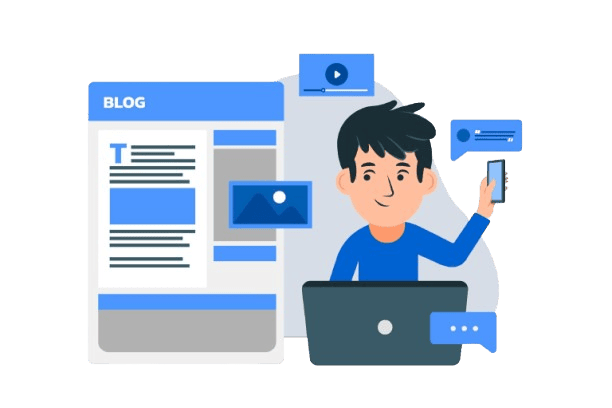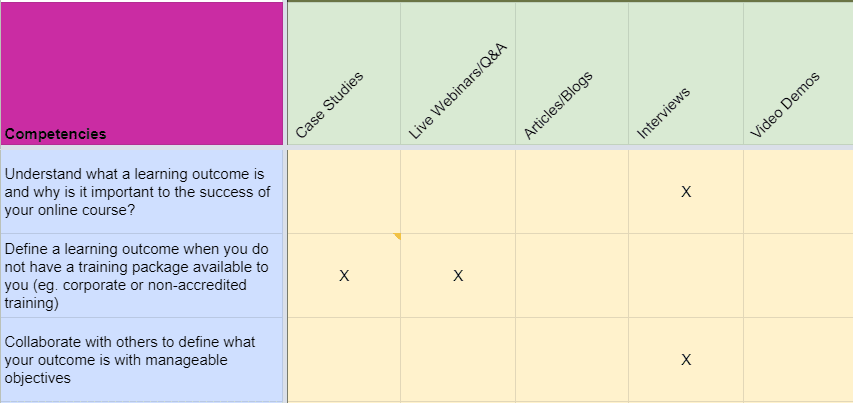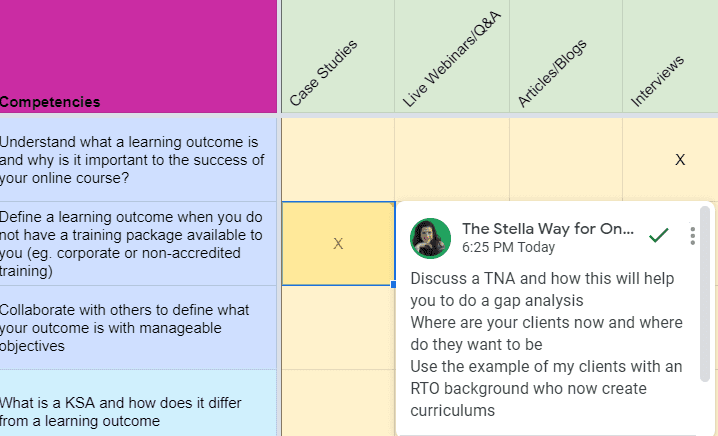
"What content types should I add to my course?"
How can you ensure this?
Step 1: Have a structured course outline
A course outline keeps you on track when creating your course content. This is what will help you to identify which content types are most appropriate.
Your course outline must include
An overall course goal that is specific in what your clients will be able to do by the end of the course. Keep this to 1 course goal. Do not overcomplicate it!
Break down the course goal into 3 - 5 learning outcomes that are the path your clients will take to reach their goals
For each learning outcome, identify the competencies your clients will need to learn to achieve the learning outcomes
Check out this helpful article on creating a course outline.
Step 2: Speak to your clients
This step needs to blend with step one. As you continue to speak to your clients you have a better understanding of what it is they want to achieve and how you can support them.
This will help you to create your course outline and lower the risk of creating content that doesn’t meet their needs.
Earlier I mentioned that this should not be their preference in how they like to consume media.
For example:
“With what medium do you best learn”, and
“How can I support you to reach your goal”
These are two different questions that will yield different results.
The first question suggests that there is only one way that your clients prefer to learn and you will provide that to them, regardless of its appropriateness.
While the second question allows you to explore your clients expectations, what they need to reach their goals and how you can package this into your course.
Step 3: Create a list of relevant content types
One word: Research!
Identify content types that are useful to support your clients throughout the course. You can do this through a Google search or by joining educational groups on LinkedIn and Facebook. Ask the community what content types they would recommend and why.
Let's look at this example:
| Learning Outcome | Competencies | Content Types |
| Add a new task card to Trello Board | Use Trello application to locate an existing Trello Board Connect Task Cards to relevant Trello lists | A video with screen share demonstrating these steps will provide the opportunities to students to practice this skill. The video can be accompanied with step by step instructions. |
See how clear this is? If all your content types are audio with images it can be detrimental to your clients success of the above learning outcome.
Which leads to Step 4.
Step 4: Map lessons to course outline
This is where the magic happens!
Now that you know what your clients need to learn to be successful in your course, and you have a list of ideal content types, you can start your mapping.
Use a matrix format (such as a Google Sheet) to list all your competencies on the left hand side and all your lessons on the top row. You can download the same matrix (below) that I use to plan my online courses here.

Clearly indicate which lessons you will use per competency in your online course. You can use an X, a colour, a tick, a number, whichever indicator you wish, just ensure that it is clear which content types you will use per competency.
Step 5: Outline what is covered in each content type
Consider this the start of your storyboard.
Ask yourself:
What information will I include in each content type?
Will this lesson support my client in learning the competencies required to achieve the learning outcome?
Is this content type the best way I can deliver this information?
Is this content relevant for the success of my clients right now?
This process will help you to confirm that you have chosen the right content type and there is not a better alternative available.
Hint: I usually type this in a comment within the matrix mapping.

Ready to create your online course?
I guide my clients through designing, creating and launching their online courses to help them reduce the stress of course creation overwhelm!



